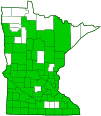clammy groundcherry
(Physalis heterophylla)
Conservation • Description • Habitat • Ecology • Use • Distribution • Taxonomy
Conservation Status |
|
|||||||
| IUCN Red List | not listed |
|||||||
| NatureServe | N5 - Secure SNR - Unranked |
|||||||
| Minnesota | not listed |
|||||||
Description |
||
Clammy groundcherry is a 8″ to 36″ tall, erect, perennial forb that rises from a tough, deep, horizontal, underground stem (rhizome). It often forms colonies. The stems are branched. The upper part of the stem is densely covered with both long, soft, shaggy hairs and sticky, glandular hairs. The leaves are alternate, thick, soft to the touch, stalked, egg-shaped or diamond-shaped, 1½″ to 4″ long, and 1½″ to 2½″ wide. They are broad and rounded or heart-shaped at the base, and taper to a point at the tip with straight sides along the tip. The margins have a few irregular teeth. The upper and lower surfaces have silky, appressed hairs as well as glandular hairs. The inflorescence is single flowers nodding at the end of ⅜″ to 3 ⁄5″ long, glandular-hairy stalks (pedicels) rising from the leaf axils. The flowers are ½″ to ¾″ long and wide. There are 5 pale yellow petals with purple to brown splotches near the center. They are fused into a bell-shaped corolla with 5 shallow lobes. The fruit is a ½″ spherical, berry, green at first, turning yellow at maturity. It is enclosed in an inflated, papery, heart-shaped, ¾″ long husk. The tip of the husk is mostly closed, and the base has a shallow indentation where it connects to the stem. The husk hangs from a pedicel that has elongated to 1⅛″. The berries are poisonous when green, edible when ripe. |
||
Height |
||
8″ to 36″ |
||
Flower Color |
||
Pale yellow with purple to brown centers |
||
Similar Species |
||
Virginia groundcherry (Physalis virginiana var. virginiana) is a shorter plant, no more than 24″ at maturity. The upper stems are covered with short, stiff hairs that are bent backward, and no glandular hairs. The leaves are narrow, taper to the base, and extend down along the stem somewhat. They lack the “clammy” feel. The fruit is an orange berry. The base of the husk is sunken (this may be difficult to distinguish from the “indented” base of clammy groundcherry). |
||
Habitat |
||
Dry. Upland woods, prairies. Full or partial sun. |
||
Ecology |
||
Flowering |
||
June to September |
||
Pests and Diseases |
||
|
||
Use |
||
|
||
Distribution |
||||
|
Sources |
|||
| 3/24/2023 | ||||
Nativity |
||||
Native |
||||
Occurrence |
||||
|
||||
Taxonomy |
|||
| Kingdom | Plantae (Plants) | ||
| Division | Tracheophyta (Vascular Plants) | ||
| Subdivision | Spermatophytina (Seed Plants) | ||
| Class | Magnoliopsida (Dicots) | ||
Order |
Solanales (nightshades, bindweeds, gooseweeds, and allies) | ||
Family |
Solanaceae (nightshade) | ||
| Subfamily | Solanoideae (nightshades and allies) | ||
| Tribe | Physaleae (groundcherries, lanterns, and allies) | ||
| Subtribe | Physalinae | ||
Genus |
Physalis (groundcherries) | ||
Subordinate Taxa |
|||
A redescription of Physalis heterophylla (Waterfall, 1958) separated the species into three varieties based in stem thickness and the density of long hairs. A later analysis (J. R. Sullivan, 2004) concluded that there was too much overlap in these characteristics to warrant recognition of the varieties. Today (2023), some sources, including ITIS, GBIF, USDA PLANTS, and NatureServe, recognize two varieties, P. h. var. rowellii and P. h. var. heterophylla. Other sources, including GRIN, NCBI, iNaturalist, Plants of the World Online, and World Flora Online, recognize no varieties. |
|||
Synonyms |
|||
Physalis ambigua Physalis heterophylla var. ambigua Physalis heterophylla var. clavipes Physalis heterophylla var. heterophylla Physalis heterophylla var. nyctaginea Physalis heterophylla var. rowellii Physalis heterophylla var. villosa Physalis nyctaginea Physalis sinuata |
|||
Common Names |
|||
clammy ground-cherry clammy groundcherry |
|||
Glossary
Corolla
A collective name for all of the petals of a flower.
Glandular hairs
Hairs spread over aerial vegetation that secrete essential oils. The oils act to protect against herbivores and pathogens or, when on a flower part, attract pollinators. The hairs have a sticky or oily feel.
Pedicel
On plants: the stalk of a single flower in a cluster of flowers. On insects: the second segment of the antennae. On Hymenoptera and Araneae: the narrow stalk connecting the thorax to the abdomen: the preferred term is petiole.
Rhizome
A horizontal, usually underground stem. It serves as a reproductive structure, producing roots below and shoots above at the nodes.
Visitor Photos |
|||||
Share your photo of this plant. |
|||||
| This button not working for you? Simply email us at info@MinnesotaSeasons.com. Attach one or more photos and, if you like, a caption. |
|||||
Dan W. Andree |
|||||
I think this might be some kind of Ground Cherry It was blooming at Frenchman’s Bluff SNA last June 18, 2020. But I'm not really sure just what it is. |
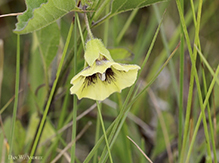 |
||||
MinnesotaSeasons.com Photos |
|||||
Plant |
|||||
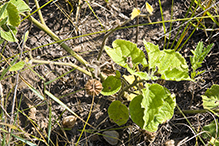 |
 |
||||
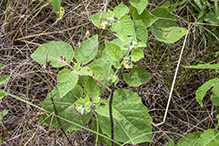 |
|||||
Leaves |
|||||
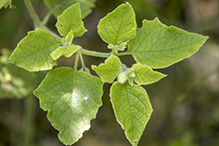 |
|||||

Slideshows |
||

Visitor Videos |
|||
Share your video of this plant. |
|||
| This button not working for you? Simply email us at info@MinnesotaSeasons.com. Attach a video, a YouTube link, or a cloud storage link. |
|||
Other Videos |
|||
| EatTheWeeds: Episode 58: Ground Cherries, Physalis EatTheWeeds |
|||
About
Dec 17, 2008 http://www.eattheweeds.com/physalis-tomatos-wild-cousin-2/ Learn about wild food with Green Deane about the edible ground cherry (physalis) a wild edible that has found its way into cultivation. |
|||


|
Created: Last Updated: © MinnesotaSeasons.com. All rights reserved. |
